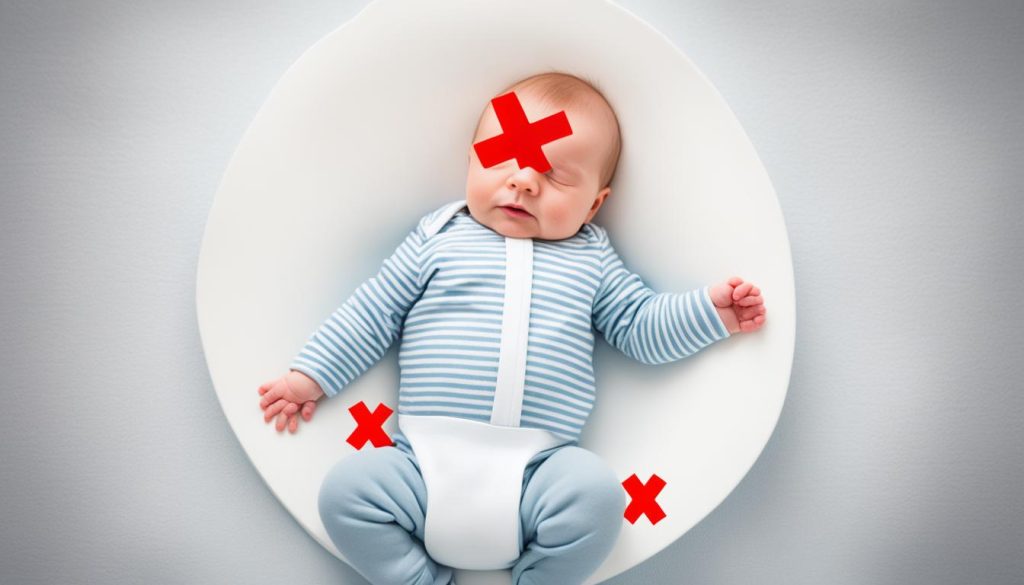Did you know that babies often adopt a sleeping posture with their butts in the air? It may seem strange, but this position is a common sight among little ones during their slumber. In this article, we will explore the reasons behind this sleep position and discuss its significance for infant development and comfort.
The Prone Sleep Position and Its Association with SIDS
The prone sleep position, also known as stomach sleeping, is a common position that babies naturally gravitate towards, especially in the first few months of life. However, it is important to be aware of the association between prone sleeping and the risk of Sudden Infant Death Syndrome (SIDS).
Experts recommend that babies be placed to sleep on their backs until they are at least six months old, and some advise following safe sleep habits until the age of one. This is because stomach sleeping has been identified as a risk factor for SIDS, a tragic and devastating condition that can occur in infants.
SIDS is the sudden and unexplained death of an otherwise healthy baby, typically occurring during sleep. While the exact cause of SIDS is unknown, research has shown a strong correlation between stomach sleeping and SIDS cases.
To reduce the risk of SIDS, it is crucial to prioritize safe sleep practices. The Back to Sleep campaign, launched in 1994 by the American Academy of Pediatrics (AAP), advocates for placing babies on their backs to sleep. This sleep position has been found to significantly reduce the incidence of SIDS.
By placing babies on their backs, the risk of suffocation and accidental smothering is minimized. Additionally, back sleeping allows for proper air circulation and maintains an open airway, reducing the likelihood of oxygen deprivation.

It is important to note that once babies can independently roll over from their back to their stomach, it is generally safe to leave them in the position they assume during sleep. However, it is crucial to always start them off on their backs and ensure a safe sleep environment.
To create a safe sleep environment, consider the following recommendations:
- Use a firm mattress or crib surface.
- Remove pillows, blankets, and stuffed animals from the sleeping area.
- Avoid overheating the room where the baby sleeps.
- Ensure a smoke-free environment.
- Keep the baby’s sleep area close to the parent’s bed but separate, such as in a bassinet or crib.
By following these guidelines and prioritizing safe sleep practices, parents and caregivers can help protect infants from the risk of SIDS associated with stomach sleeping.
| Sleep Position | Risk of SIDS |
|---|---|
| Stomach sleeping | Increased risk |
| Back sleeping | Significantly reduced risk |
| Rolling over | Generally safe once babies can do it on their own |
Why Do Babies Sleep with Their Butt in the Air?
Resemblance to the Fetal Position and Crawling Development
The curled-up posture with the butt in the air that babies often adopt during sleep may remind them of the fetal position they were in while in the womb. This position can offer a sense of familiarity and security as it replicates the snugness and comfort they experienced before birth.
Furthermore, this sleep posture may also play a role in the development of motor skills, specifically crawling. Some experts suggest that the position with the butt in the air can be a precursor to crawling, as it encourages babies to engage their muscles and practice weight shifting.
Although infants who exclusively sleep on their backs may experience a slight delay in motor skill development, the difference is minimal and can be compensated through other activities. One such activity is tummy time, where babies spend supervised time on their stomachs to strengthen their neck, back, and shoulder muscles.
During tummy time, babies have the opportunity to practice lifting their heads, pushing up on their arms, and eventually crawling. This exercise helps develop their motor skills and prepares them for more advanced movements and milestones.
The Importance of Tummy Time for Motor Skills
Tummy time is crucial for the overall development of infants. By placing babies on their stomachs when they are awake and alert, parents and caregivers can facilitate the strengthening of their neck, back, and core muscles, as well as their balance and coordination.
When babies spend time on their tummies, they learn to push up on their arms, prop themselves up on their elbows, roll over, and eventually crawl. These movements are essential for the development of their gross motor skills, which enable them to control and coordinate their body movements.
Engaging in regular tummy time sessions not only helps babies develop strong and coordinated muscles but also provides an opportunity for them to explore their surroundings from a different perspective. It promotes sensory exploration and builds their spatial awareness, contributing to their overall physical and cognitive development.
Parents can start incorporating tummy time into their baby’s daily routine from birth, gradually increasing the duration as the baby grows stronger and more comfortable. It is important to ensure a safe and supportive environment during tummy time, with a soft surface and supervision at all times.
Encouraging Crawling through Play and Exploration
In addition to tummy time, parents and caregivers can encourage crawling development through play and exploration. Providing a safe and stimulating environment that encourages movement can motivate babies to practice their motor skills.
Placing toys just out of reach or creating obstacle courses with pillows or cushions can entice babies to move and explore their surroundings. This not only stimulates their curiosity but also prompts them to engage their muscles, coordinate their movements, and build their crawling abilities.
Remember to celebrate and support each milestone and progress your baby makes, as every child develops at their own pace. If you have concerns about your baby’s motor skills or developmental progress, it is always best to consult with a pediatrician or qualified healthcare professional for personalized guidance and reassurance.

Yogic Influence on Sleeping Posture
The sleeping position with the butt in the air resembles the “child’s pose” in yoga. This posture, known for its benefits in stretching muscles and promoting relaxation, may hold the key to why babies naturally adopt this position during sleep.
In the child’s pose, the body is curled up with the knees bent and the forehead resting on the floor. This gentle and restorative pose helps release tension in the back, hips, and shoulders. It is often used as a starting point and resting pose in yoga practice, allowing practitioners to reconnect with their breath and find a sense of calm and centeredness.
Similarly, babies may find the butt-in-the-air sleep position soothing and comforting. It offers a natural stretch for their growing muscles and promotes a sense of relaxation. Just as yoga can help adults reduce stress and tension, the child’s pose-inspired sleeping posture may aid babies in relaxation and stress reduction during sleep.

Benefits of the Child’s Pose in Yoga:
- Promotes relaxation and stress reduction
- Stretches muscles in the back, hips, and shoulders
- Calms the mind and centers the body
- Encourages deep breathing and a sense of rejuvenation
| Normal Sleep Position | Child’s Pose-inspired Sleep Position |
|---|---|
| Back sleeping | Butt in the air |
| Relaxed muscles | Stretched muscles |
| Neutral spine alignment | Curved spine alignment |
| Safe sleep position to reduce SIDS risk | Potential stress reduction through yoga-inspired posture |
Transitioning Sleep Patterns as Babies Grow
As babies continue to grow and develop, their sleep patterns and positions may naturally change. One significant milestone in their sleep journey is the ability to roll over, which typically occurs around four months old. While it is recommended to place babies on their backs for sleep to reduce the risk of Sudden Infant Death Syndrome (SIDS), once they can independently roll over, it is generally considered safe to leave them in whatever sleeping position they assume.
Babies may transition from back sleeping to other positions, such as sleeping on their tummies or their sides, based on their personal preference, comfort, and developmental milestones. Some babies may prefer to sleep on their backs even after they can roll over, while others may find more comfort in different positions. Personal preference plays a significant role in how babies sleep, just like it does for adults.
It’s important for parents to understand that once babies are capable of rolling over, they have the strength and mobility to adjust themselves during sleep. This means that even if parents place their baby on their back, they may naturally roll onto their tummy or side throughout the night. This is generally safe, as long as the sleep environment remains conducive to safe sleep practices. However, it is essential to always start babies off on their backs and ensure that the crib or bassinet is free of any potential hazards.

In some cases, babies may continue to roll over onto their stomachs for sleep, while others may begin to favor back sleeping once again. This transition depends on the individual baby and their comfort. It is important for parents to monitor their baby’s sleep position and ensure they are looking out for their safety.
By allowing babies to find their preferred sleep positions, parents can support their growing independence and encourage them to develop healthy sleep habits. It is recommended to continue placing babies on their backs for sleep until they reach one year old, as this position is associated with a reduced risk of SIDS. However, every baby is unique, and it’s important to follow their cues and consult with a pediatrician for any concerns or questions about their sleep patterns.
| Age | Sleep Position | Notes |
|---|---|---|
| 0-4 months | Back sleeping | Safe sleep position to reduce the risk of SIDS. |
| 4+ months | Rolling over | Babies can roll over on their own and assume different sleep positions. |
| 4+ months | Tummy or side sleeping | Babies may naturally gravitate towards these positions based on their comfort and preference. |
| 5-6 months | Back sleeping recommences | Some babies may prefer back sleeping again, while others may continue to favor other positions. |
Safety Considerations
While the butt-in-the-air sleep position may appear cute, it is important to prioritize safe sleep practices to reduce the risk of Sudden Infant Death Syndrome (SIDS). The American Academy of Pediatrics recommends placing babies on their backs for sleep for the first year of life, as back sleeping has been shown to significantly reduce the risk of SIDS. This means ensuring that the baby sleeps on their back when initially placed in the crib or bassinet.
If babies are strong enough to roll over on their own and assume the prone position (belly sleeping), it is generally safe to let them sleep in that position. However, it is crucial to always start them off on their backs to reduce the risk of SIDS. Remember, back sleeping is the safest sleep position for babies.
Creating a safe sleeping environment is equally important. Remove all loose bedding, pillows, and stuffed animals from the crib or bassinet to prevent suffocation hazards. The mattress should be firm, and the crib or bassinet should meet safety standards. Additionally, avoid exposing the baby to secondhand smoke, as it increases the risk of SIDS.
| Sleep Position | SIDS Risk | Guidelines |
|---|---|---|
| Back Sleeping | Lowest | Place babies on their backs for sleep. |
| Belly Sleeping | Higher | Only if the baby can independently roll over and assume the prone position. |
Transitioning out of the Butt-in-the-Air Position
The age at which babies stop sleeping with their butts in the air varies. On average, babies start rolling over and sleeping on their tummies around five to six months of age. However, the transition back to back sleeping depends on the individual baby’s personal preference. Some babies may naturally gravitate towards sleeping on their backs, while others may continue to prefer sleeping on their tummies. It is important to continue placing babies on their backs for sleep until they reach one year old, following safe sleep practices.
As babies grow and develop, they become more mobile and may start rolling over independently during sleep. Once babies are capable of rolling over on their own, it is generally considered safe to let them find their preferred sleep posture. However, it is essential to create a safe sleep environment by removing any pillows, blankets, or soft objects from the crib. Placing baby on a firm mattress with a fitted sheet and ensuring the room is at a comfortable temperature can also contribute to better sleep.
Transitioning out of the butt-in-the-air position is a natural part of a baby’s sleep journey. It is a sign of their developing motor skills and growing independence. As parents and caregivers, it is important to observe and adapt to their changing needs, ensuring their comfort and safety throughout the transition. If you have any concerns or questions about your baby’s sleep position or habits, it is always best to consult with a pediatrician for personalized guidance.
Tips for a Smooth Transition:
- Continue placing your baby on their back for sleep until they reach one year old.
- Create a safe sleep environment by removing pillows, blankets, and soft objects from the crib.
- Ensure the mattress is firm and the fitted sheet is secure.
- Keep the room at a comfortable temperature for sleep.
- Observe your baby’s preferences and adapt to their changing sleep positions.
- Consult with a pediatrician if you have any concerns or questions.
Conclusion
Babies sleeping with their butt in the air is a common sleep position that may be reminiscent of the fetal position and offer a sense of comfort and security. While it is important to prioritize safe sleep practices and place babies on their backs, once they can independently roll over and assume the prone position, it is generally safe to let them find their preferred sleep posture.
As babies grow and develop, their sleep patterns may transition, and they may adopt different sleep positions based on their personal preference and comfort. However, it is important to always start them off on their backs and ensure a safe sleeping environment.
If you have any concerns or questions about your baby’s sleep position or any other sleep-related matters, it is always advisable to consult with a pediatrician for personalized guidance. They can provide you with the best advice and recommendations based on your baby’s individual needs.
FAQ
1. Why do babies sleep with their butt in the air?
Babies often adopt a sleeping posture with their butts in the air due to the resemblance to the fetal position they were in while in the womb. This position can offer a sense of familiarity and security to them.
2. Is the butt-in-the-air sleep position safe for babies?
While the butt-in-the-air sleep position may appear cute, it is not considered the ideal sleep position for preventing Sudden Infant Death Syndrome (SIDS). It is crucial to put babies to sleep on their backs for the first year, following safe sleep guidelines.
3. When can babies start sleeping on their tummies?
Babies typically start rolling over and sleeping on their tummies around five to six months of age. However, it is important to continue placing babies on their backs for sleep until they reach one year old.
4. How do I ensure a safe sleeping environment for my baby?
To create a safe sleeping environment, place your baby on a firm mattress with a fitted sheet and remove any pillows, soft bedding, or stuffed animals from the crib. Ensure the room temperature is comfortable and avoid overdressing the baby to prevent overheating. Also, make sure to keep cords, curtains, and other potential hazards away from the crib.
5. Should I be concerned if my baby consistently sleeps in the butt-in-the-air position?
It is common for babies to adopt different sleep positions, including the butt-in-the-air position. As long as safe sleep practices are followed and the baby is placing themselves in that position, there is usually no cause for concern.




